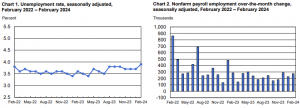March 8, 2024
In February, total nonfarm payroll employment in the United States increased by 275,000 jobs, according to the U.S. Bureau of Labor Statistics. However, the unemployment rate also rose slightly to 3.9 percent. Job gains were observed across various sectors including health care, government, food services and drinking places, social assistance, and transportation and warehousing. This suggests a robust labour market with growth in several key industries, despite a slight uptick in unemployment. The U.S. Bureau of Labor Statistics reported these findings based on two monthly surveys: the household survey, which assesses labor force status, including unemployment by demographic characteristics, and the establishment survey, which measures nonfarm employment, hours, and earnings by industry.

Household Survey Data
In February, the unemployment rate in the United States rose by 0.2 percentage points to 3.9 percent, with the number of unemployed individuals increasing by 334,000 to 6.5 million. A year prior, the unemployment rate stood at 3.6 percent, with 6.0 million people unemployed. Among major worker groups, the unemployment rates for adult women and teenagers increased during the month, while rates for adult men, Whites, Asians, and Hispanics remained relatively stable. The jobless rate for Blacks saw a slight increase. Notably, there was an increase in the number of permanent job losers, rising by 174,000 to reach 1.7 million individuals. The count of individuals on temporary layoff remained relatively stable at 827,000. Additionally, the number of long-term unemployed (27 weeks or more) remained largely unchanged at 1.2 million, constituting 18.7 percent of all unemployed individuals.
key labour market indicators in the United States remained relatively stable in February. The labour force participation rate held steady at 62.5 percent for the third consecutive month, while the employment-population ratio showed little change at 60.1 percent, mirroring figures from the previous year. The number of individuals employed part-time for economic reasons remained unchanged at 4.4 million, reflecting those who desired full-time employment but were working part-time due to reduced hours or inability to secure full-time positions. Additionally, the number of people not in the labour force but wanting a job remained largely steady at 5.7 million, with 1.6 million considered marginally attached to the labour force, indicating a desire and availability for work. Among these, the number of discouraged workers, who believed no jobs were available for them, remained little changed at 425,000.
Establishment Survey Data
In February, total nonfarm payroll employment in the United States saw a robust increase of 275,000 jobs, surpassing the average monthly gain of 230,000 over the past year. Key sectors driving this growth included health care, which added 67,000 jobs, with notable gains in ambulatory health care services, hospitals, and nursing and residential care facilities. Government employment rose by 52,000, largely driven by local government excluding education and federal government positions. Job gains were also observed in food services and drinking places (+42,000), social assistance (+24,000), transportation and warehousing (+20,000), and construction (+23,000). Despite these gains, retail trade employment remained relatively stable, while several other major industries showed little change in employment levels.
In February, average hourly earnings for all employees on private nonfarm payrolls in the United States saw a modest increase of 5 cents to $34.57, following a more substantial rise of 18 cents in January. This represented a 0.1 percent uptick in February and a 4.3 percent increase over the year. Similarly, average hourly earnings for private-sector production and nonsupervisory employees edged up by 7 cents to $29.71, reflecting a 0.2 percent increase. Additionally, the average workweek for all employees on private nonfarm payrolls increased slightly by 0.1 hour to 34.3 hours, rebounding from a decline in January. Within manufacturing, the average workweek remained stable at 39.9 hours, with a slight increase in overtime to 3.0 hours.
The U.S. Bureau of Labor Statistics reported revisions to the nonfarm payroll employment figures for December and January indicate a downward adjustment in job gains. December’s employment change was revised down by 43,000 from +333,000 to +290,000, while January’s figures were revised down by a more substantial 124,000 from +353,000 to +229,000. Consequently, the combined employment for the two months is now reported as 167,000 lower than previously stated. These revisions, a routine part of the reporting process, reflect additional data received from businesses and government agencies, as well as adjustments to seasonal factors, providing a more accurate reflection of employment trends during those months.
Disclaimer:
Analyst Certification – The views expressed in this research report accurately reflect the personal views of Mayberry Investments Limited Research Department about those issuer (s) or securities as at the date of this report. Each research analyst (s) also certify that no part of their compensation was, is, or will be, directly or indirectly, related to the specific recommendation(s) or view (s) expressed by that research analyst in this research report.
Company Disclosure – The information contained herein has been obtained from sources believed to be reliable, however its accuracy and completeness cannot be guaranteed. You are hereby notified that any disclosure, copying, distribution or taking any action in reliance on the contents of this information is strictly prohibited and may be unlawful. Mayberry may effect transactions or have positions in securities mentioned herein. In addition, employees of Mayberry may have positions and effect transactions in the securities mentioned herein.
